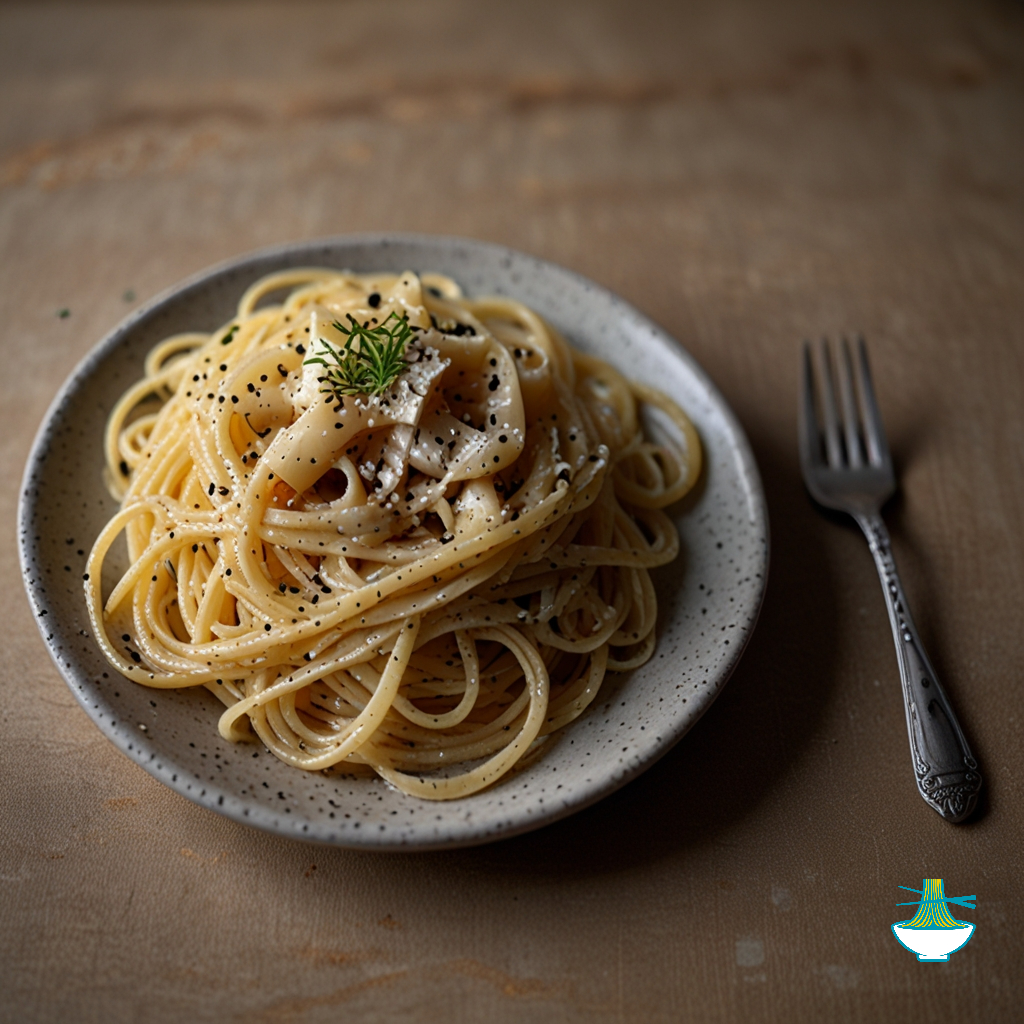Cacio e Pepe is a classic Roman pasta dish renowned for its simplicity and bold flavors. The name translates to "cheese and pepper" in Italian, highlighting the main ingredients that define this dish. It traditionally features spaghetti or other pasta tossed with grated Pecorino Romano cheese and freshly ground black pepper, creating a creamy and peppery sauce that clings perfectly to the noodles.
The origins of Cacio e Pepe trace back to the simple meals prepared by shepherds in the countryside of Rome. With limited ingredients on hand, they crafted this flavorful dish using the staples of their region: aged sheep's milk cheese (Pecorino Romano) and black pepper. Over time, it evolved into a beloved Roman specialty, celebrated for its rustic charm and delightful taste.
Today, Cacio e Pepe continues to be a favorite among pasta enthusiasts worldwide, cherished for its harmonious blend of cheese and spice, making it a timeless and comforting dish that embodies the essence of Italian culinary heritage.
Ingredients:
- 8 ounces spaghetti or other pasta
- 1 cup grated Pecorino Romano cheese
- 1 tablespoon freshly ground black pepper
- Salt to taste
- Extra virgin olive oil (optional)
Method of Preparation:
1. Cook the pasta in a large pot of salted boiling water until al dente. Reserve about 1 cup of pasta water before draining.
2. In a separate pan, toast the black pepper over medium heat for about 1-2 minutes until fragrant.
3. Transfer the toasted pepper to a large mixing bowl. Add the grated Pecorino Romano cheese.
4. Add the cooked pasta to the bowl with the cheese and pepper. Toss well to combine, adding a little pasta water at a time until a creamy sauce forms.
5. Adjust the seasoning with salt if needed.
6. Optionally, drizzle with a bit of extra virgin olive oil before serving.
7. Serve hot, garnished with additional Pecorino Romano cheese and black pepper if desired.
Nutrition Value:
1. 8 ounces spaghetti or other pasta:
- Calories: Approximately 800 calories (depending on the type of pasta)
- Carbohydrates: Around 160 grams
- Protein: Roughly 24 grams
- Fat: Minimal, usually around 2-3 grams
- Sodium: Varies based on preparation, typically around 10-15 milligrams
- Cholesterol: Very low, usually less than 1 milligram
- Vitamins: Contains small amounts of B vitamins, especially folate and niacin
- Minerals: Provides small amounts of iron and magnesium
- Nutritional Benefit: Pasta is a good source of energy due to its carbohydrate content. Whole wheat pasta adds fiber and nutrients like manganese and selenium.
2. 1 cup grated Pecorino Romano cheese:
- Calories: Around 420 calories
- Carbohydrates: Less than 2 grams
- Protein: Approximately 28 grams
- Fat: Around 34 grams
- Sodium: About 1,600 milligrams
- Cholesterol: Roughly 100 milligrams
- Vitamins: Rich in vitamin A and calcium
- Minerals: Contains significant amounts of calcium and phosphorus
- Nutritional Benefit: Pecorino Romano cheese adds protein, calcium, and flavor to the dish. However, it's high in sodium and should be consumed in moderation, especially for individuals monitoring their sodium intake.
3. 1 tablespoon freshly ground black pepper:
- Calories: Approximately 16 calories
- Carbohydrates: About 4 grams
- Protein: Around 1 gram
- Fat: Less than 1 gram
- Sodium: Minimal, less than 1 milligram
- Cholesterol: None
- Vitamins: Contains small amounts of vitamin K and manganese
- Minerals: Provides trace amounts of iron and copper
- Nutritional Benefit: Black pepper is rich in antioxidants and may have anti-inflammatory properties. It adds flavor without significant calories or nutrients.
4. Salt to taste:
- Sodium: Depends on the amount added, usually less than 500 milligrams per serving
- Cholesterol: None
- Nutritional Benefit: Salt enhances the flavor of the dish but should be used in moderation, especially for individuals with hypertension or other sodium-sensitive conditions.
5. Extra virgin olive oil (optional):
- Calories: Around 120 calories per tablespoon
- Carbohydrates: None
- Protein: None
- Fat: Approximately 14 grams (mostly monounsaturated fats)
- Sodium: Minimal, less than 1 milligram
- Cholesterol: None
- Vitamins: Rich in vitamin E and vitamin K
- Minerals: Contains small amounts of iron and calcium
- Nutritional Benefit: Extra virgin olive oil is a healthy fat, high in monounsaturated fats and antioxidants. It can improve heart health and contribute to overall well-being when used in moderation.


Comments